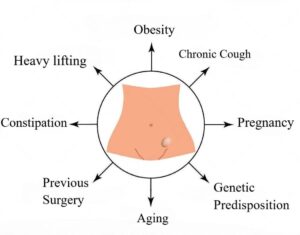

Do you experience a bulge in your abdomen or groin that becomes more noticeable when you cough or strain?
Do you suffer from:
Then it is an alarm to wake up and realise – you may be suffering from hernia. Explore the article to learn more and take proactive steps in managing hernias effectively.
Hernia occurs when an internal organ or tissue bulges out through a weak spot in the surrounding muscle or connective tissue

Following are the most common risk factors for the development of hernia –

Hernias can present with a wide range of symptoms depending upon location, content of sac and severity of the condition. Most usual presentation being:
In severe cases, when the contents become irreducible and the blood supply hampers they may present in emergency with:
There are other types of hernias which are rare in their presentations like Diaphragmatic hernia, Congenital hernia, Lumbar hernia, Spigelian hernia, etc.

Surgery is the only option for most of the hernias. However, we can have a wait-and-watch approach for a few hernias like Small umbilical hernia/ Congenital umbilical hernia (hernia present at birth) which was detected incidentally with no symptoms.
Planning for surgery whether to post case electively or to post immediately depends on the presentation of the patient i.e., whether the patient presented with mild symptoms or presented with complications in a life-threatening condition. Early surgical intervention prevents complications and ensures faster recovery. Different surgical options are available based on type of hernia and severity.

| FACTOR | OPEN REPAIR | LAPAROSCOPIC REPAIR |
| Approach | Single large incision over the hernia site | Small incisions with a camera (laparoscope) and instruments |
| Anaesthesia | Local, regional, or general anaesthesia | General anaesthesia required |
| Mesh Placement | Mesh placed over or under the muscle | Mesh placed inside the abdominal wall |
| Pain & Recovery | Relatively more post-op pain, longer recovery | Less post-op pain, faster recovery |
| Scarring | Larger scar at the incision site | Minimal scarring due to small incisions |
| Complications | Infection risk higher | Risk of organ injury, but lower infection rate |
| Suitability | Preferred for large, irreducible or recurrent hernias | Preferred for bilateral or recurrent hernias |
|
FACTOR |
OPEN REPAIR |
LAPAROSCOPIC REPAIR |
|
Approach |
Single large incision over the hernia site |
Small incisions with a camera (laparoscope) and instruments |
|
Anaesthesia |
Local, regional, or general anaesthesia |
General anaesthesia required |
|
Mesh Placement |
Mesh placed over or under the muscle |
Mesh placed inside the abdominal wall |
|
Pain & Recovery |
Relatively more post-op pain, longer recovery |
Less post-op pain, faster recovery |
|
Scarring |
Larger scar at the incision site |
Minimal scarring due to small incisions |
|
Complications |
Infection risk higher |
Risk of organ injury, but lower infection rate |
|
Suitability |
Preferred for large, irreducible or recurrent hernias |
Preferred for bilateral or recurrent hernias |
Post operative care includes pain management and lifestyle modifications to promote healthy healing and recovery.
Feel free to come and visit our clinic – “VIZAG SURGICARE” in case of any pain or persistent bulge in your body. We ensure a comprehensive approach in treating hernia which best suits your presentation combining expertised skills and personalised post operative care to guide you for healthy and faster recovery.
Mobile No 1 : +91-77029 50513
Mobile No 2 : +91-9848638615
Mobile No 3 : +91-9849239213
First Floor, Mohan Medical Shop, Seethammadhara (NE), Visakhapatnam-530013
info@vizagsurgicare.com
WhatsApp us